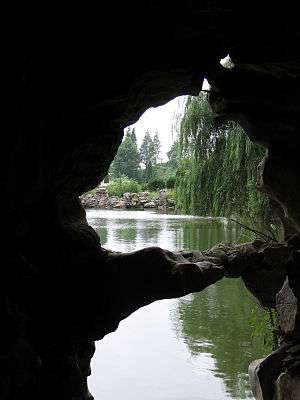Grotto-heavens

View from inside Taiji Cave grotto-heaven (simplified Chinese: 太极洞; traditional Chinese: 太極洞; pinyin: Tàijí Dòng; literally: "Cave of the Supreme Ultimate") is a karst cave located on Shilong Mountain (石龙山), in Guangde County, Xuancheng City, Anhui Province, People's Republic of China.
| Part of a series on |
| Taoism |
|---|
 |
|
Deities |
|
Holy places |
|
Organisations |
| Portal Taoism |
Grotto-heavens (Chinese: 洞天; pinyin: Dòngtian) are a type of sacred Taoist site. Grotto-heavens are usually caves, grottoes, mountain hollows, or other underground or semi-underground spaces. Because every community was supposed to have access to at least one grotto, there were many of them all over China. They were first organized systematically in the Tang Dynasty by Sima Chengzhen 司馬承禎 (647–735, see Zuowanglun) and Du Guangting 杜光庭 (850-933).[1] The most sacred of these sites were divided into two types: The ten greater grotto-heavens and the thirty-six lesser grotto-heavens.[2]
The ten greater grotto-heavens are as follows:
- Mt. Wangwu grotto 王屋山 (Henan)
- Mt. Weiyu grotto 委羽山 (Zhejiang)
- Mt. Xicheng grotto 西城山 (Shanxi)
- Mt. Xixuan grotto 西玄山 (Sichuan)
- Mt. Qingcheng grotto 青城山 (part of Huashan, Shanxi)
- Mt. Chicheng grotto 赤城山 (Guangdong)
- Mt. Luofu grotto 羅浮山 (Guangdong)
- Mt. Gouqu grotto 句曲山 (Jiangsu, in Lake Tai)
- Mt. Linwu grotto 林屋山 (on Maoshan, Jiangsu)
- Mt. Kuocang grotto 括蒼山 (Zhejiang)
References
Sources
- Mt. Kohn, Livia, ed. Daoism Handbook (Leiden: Brill, 2000).
See also
- Buddhist grottoes (China)
- Sacred Mountains of China
- Xianren Cave
This article is issued from
Wikipedia.
The text is licensed under Creative Commons - Attribution - Sharealike.
Additional terms may apply for the media files.